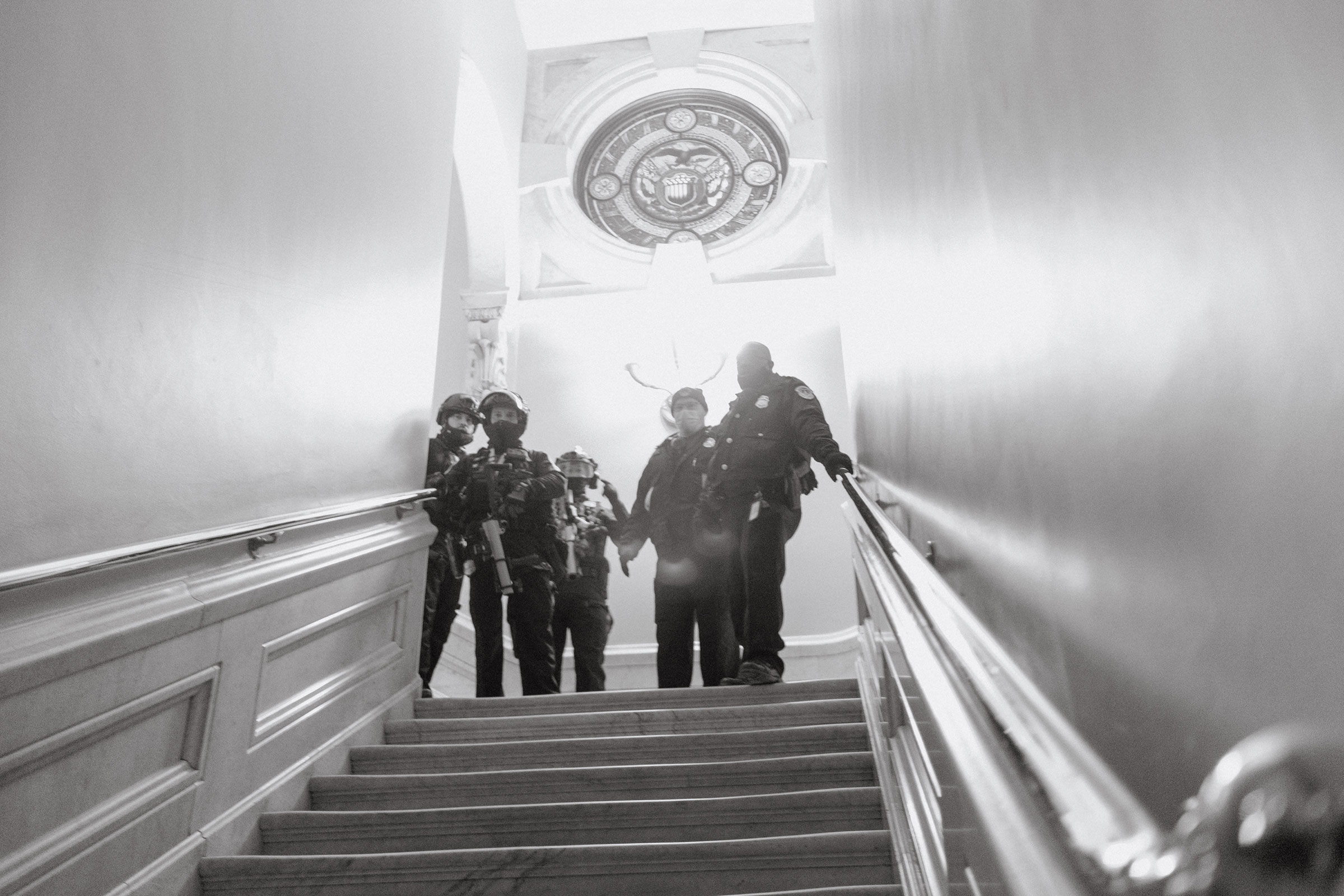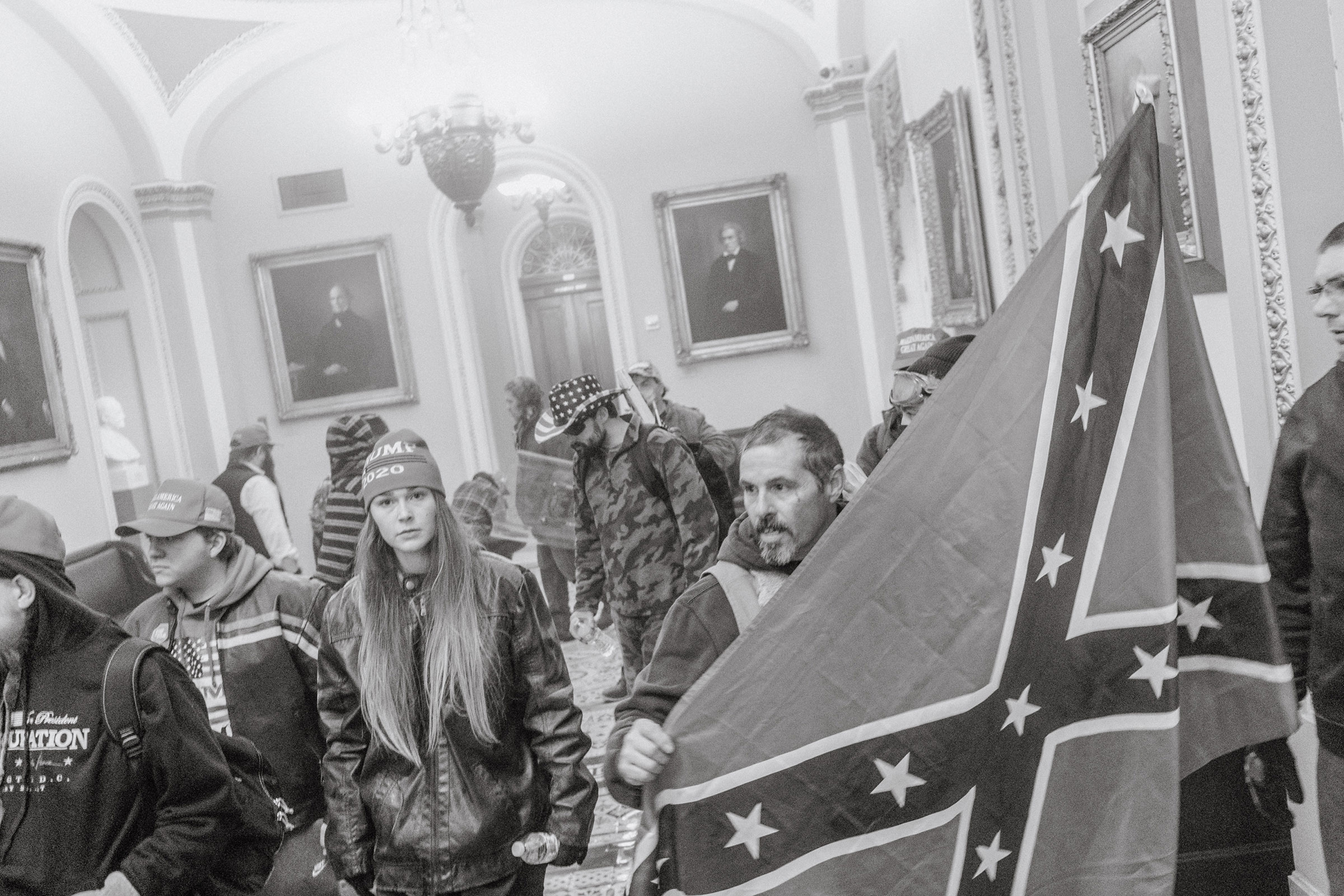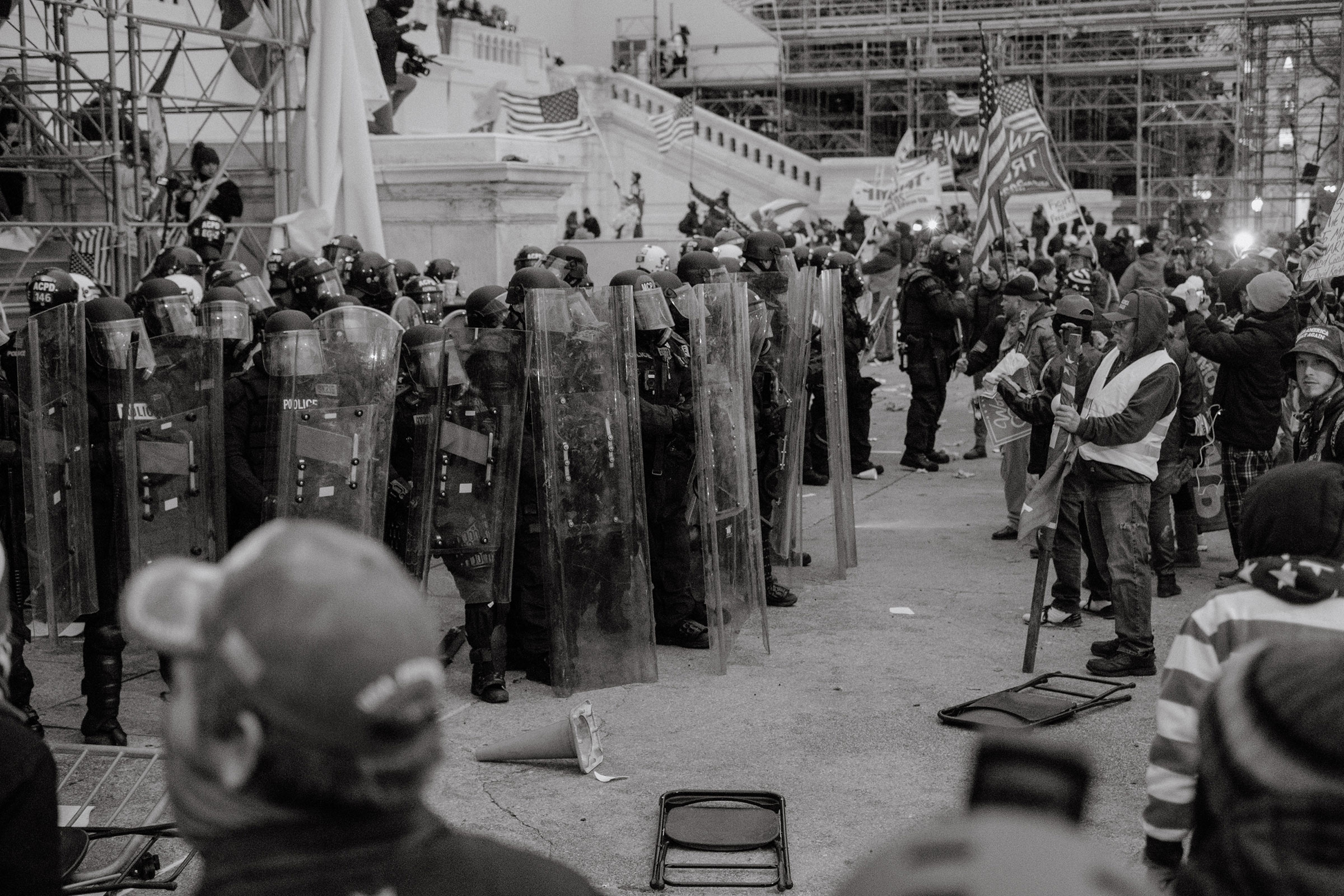
Dozens of video clips posted to social media on Wednesday captured the image of outnumbered D.C. law enforcement officers apparently being overwhelmed by waves of pro-Trump rioters, who swarmed police barricades, sprayed chemical agents, smashed windows, and entered the U.S. Capitol building by brute force. It was the first time since the War of 1812 that the building was breached.
In the aftermath of the violence, lawmakers, civil rights leaders and former law enforcement officials began to question how the defenses at the center of the nation’s government could have failed so easily. The U.S. Capitol Police, which has a force of about 2,000 officers, along with city authorities, had been aware of the Jan. 6 pro-Trump rally for weeks. And Capitol Police Chief Steven Sund, said in a statement on Jan. 7 that officers had had a “robust plan” to deal with expected unrest.
So why was it that, when protests turned violent, law enforcement lost control almost immediately?
Footage shows a small line of police officers on the Capitol steps bowled over by a mob that President Donald Trump had incited with a speech earlier that day calling on them “to take back our country.” Despite meticulous training and contingency plans for a host of scenarios from terrorist attacks to biohazards, the Capitol Police seemed unprepared when the threat arrived in the form of mostly white men carrying American flags. Some observers noted that law enforcement had apparently ignored the seriousness of the threat of domestic far-right extremists, as they’ve done for years. Others suggested that police were perhaps complicit with the insurrectionists, many of whom express pro-police beliefs. Lawmakers have called for multiple investigations into the security failures.
One video appears to show a Capitol Police officer taking selfies with the rioters. Another featured several officers removing metal barriers to let the mob freely pass toward the Capitol. In yet another video, an officer appeared to hold a door open so a handful of rioters, apparently allowing them to exit the Capitol building without being arrested or charged.

Civil rights activists were quick to compare the Capitol Police officers’ lackluster response on Jan. 6 with the overwhelming display of force by police at Black Lives Matter protests over the summer. “When Black folks are protesting and progressives are protesting peacefully they were tear-gassed, they were arrested, they were shot with rubber bullets. They were shot with real bullets,” said Derrick Johnson, the NAACP’s president and chief executive. “We watched it take place all summer long when people were peacefully demonstrating.”
Former officials and security analysts blamed both police and Department of Homeland Security leaders for not treating the pro-Trump rallies—which included well-known groups of white supremacists, far-right extremists and self-styled militias—as a serious threat. None of this should have come as a shock to them: crowds of often armed demonstrators, made up of many of the same right-wing groups, had overcome police and stormed the Michigan and Idaho statehouses this summer.

“I thought this was a dry run for what we might see around the election or the inauguration,” says Daryl Johnson, a former DHS senior analyst who authored a controversial 2009 report warning of the rise of right-wing extremism. “What we witnessed yesterday didn’t surprise me at all.”
This exact scenario is the “culmination of years of federal government neglect of this threat,” says Johnson. Faced with insufficient money and resources to combat far-right extremism, those movements have been allowed to metastasized online. Meanwhile, Trump and conservative politicians continued to pander to these extremist groups. “This is what happens when you neglect a threat and let it grow year after year, plot after plot, attack after attack,” Johnson says.
More than 50 Capitol and DC Police officers sustained injuries during the attack, according to Capitol Police Chief Sund, who described the crowd as “determined to enter into the Capitol” with “violent riotous actions.”
“The violent attack on the U.S. Capitol was unlike any I have ever experienced in my 30 years in law enforcement here in Washington, D.C.,” Sund said. “But make no mistake – these mass riots were not First Amendment activities; they were criminal riotous behavior. The actions of the USCP officers were heroic given the situation they faced.”
Rep. Dean Phillips, a Democrat from Minnesota, told reporters, describing the Capitol Police partly defended the officers. “They were outmanned today. They were outgunned,” he said. “They did the best they could with what they had but that was not nearly enough.”
One woman – who was identified as 35-year old Ashli Babbitt from San Diego – was fatally shot by Capitol Police as the crowd tried to push their way towards the House Chamber, where lawmakers were sheltering in place. Three other people also died on the grounds of the Capitol when they experienced “medical emergencies,” according to the police.
Calling in the National Guard
One factor in the cautious response appears to have been Washington D.C. Mayor Muriel Bowser’s recent decision to limit the law enforcement’s role in responding to civil unrest. Last summer, federal law enforcement clashed with demonstrators protesting the death of George Floyd, an unarmed Black man who was killed by a Minneapolis police officer last May. The demonstrators, which included many people of color, were met with tear gas, rubber bullets and, in one case, low-flying military helicopters who blasted an awestruck crowd with a downwash of air, debris and fuel exhaust.
In the wake of those clashes, Bowser and other city authorities worked to limit the overzealous show of force by requesting National Guard troops to be present for the protests, but in a limited role. This was evident on Jan. 6, when roughly 340 troops with the D.C. National Guard were activated, but ordered to be unarmed and only provide back up to police with street closures. The troops set up posts at several Metro train stations.
Instead of wearing usual camouflage bulletproof vests and carrying rifles, Guard members each wore a black “identification vest” featuring the troops’ name, rank and service. It is the traditional uniform worn during domestic support operations, including Presidential Inaugurations, the 4th of July celebration and other events. “Under these authorities, the Guard was essentially acting like traffic cops,” one defense official tells TIME.
Once the crowd broke in, federal agencies were slow to respond. As the mob raided the Capitol and lawmakers evacuated to safety, the D.C. National Guard couldn’t quickly deploy to the building because they weren’t authorized, and even if they did, they didn’t have guns.
The U.S. military mainly supports local authorities through the National Guard, which is under the control of state governors, who respond to requests from local leaders. D.C. does not have a governor, so the Secretary of Defense has that responsibility, which has been delegated to the Army Secretary Ryan McCarthy by statute.

About 1,100 National Guard members were activated as the violence worsened. Troops appeared at the Capitol Wednesday evening, pushing back the crowd with raised shields and batons as D.C. police warned them through megaphones they were violating the 6 p.m. curfew.
“The D.C. Guard has been mobilized to provide support to federal law enforcement in the District,” said Jonathan Hoffman, Pentagon spokesman. The law enforcement response will be led by the Department of Justice.
At Bowser’s request, Virginia Governor Ralph Northam tweeted that he would also send members of the Virginia National Guard along with 200 Virginia state troopers to D.C. New York Gov. Andrew Cuomo also said he would deploy 1,000 of the state’s National Guard members to Washington “to aid and facilitate the peaceful transition of presidential power.”
Blame, Investigations and Steps Forward
Lawmakers of both parties who found themselves cowering on the chamber floor or barring their office doors with furniture as a mob stalked through the halls are looking for answers.
On Jan. 7, Democratic leaders on the House Appropriations committee, which allocates funding for Capitol Police, announced that it would review the agency’s response to the violence, noting the breach “raises serious questions about what law enforcement did and what they should have done differently.”
“We recognize the bravery of the Capitol Police and law enforcement officers who protected Members and essential workers in the Capitol Complex yesterday,” Reps. Rosa DeLauro and Tim Ryan said in a joint statement. “At the same time, it is obvious that there was a severe systemic failure in securing the building’s perimeter and in the response once the building was breached.”
Some lawmakers speculated that more investigations may be forthcoming. “I intend to have the Committee on House Administration work with the bipartisan House and Senate leadership to address these concerns and review the response in coming days,” said Rep. Zoe Lofgren, who chairs the committee on House Administration.
Senate Democratic Leader Chuck Schumer said that when Democrats take the majority later this month, he plans to fire Mike Stenger, the Senate Sergeant-at-Arms who is in charge of security. “If Senate Sergeant-at-Arms Stenger hasn’t vacated the position by then, I will fire him as soon as Democrats have a majority in the Senate,” Schumer said in a statement to POLITICO. House Sergeant-at-Arms Paul Irving is also under pressure to step down.
Meanwhile, the FBI has created a dedicated website “seeking information that will assist in identifying individuals who are actively instigating violence in Washington, DC.” They asked the public to submit tips and videos or photos of the rioting and violence at the Capitol and around the city.
“Yesterday represented a massive failure of institutions, protocols, and planning that are supposed to protect the first branch of our federal government,” said Senate Majority Leader Mitch McConnell. “The ultimate blame for yesterday lies with the unhinged criminals who broke down doors, trampled our nation’s flag, fought with law enforcement, and tried to disrupt our democracy, and with those who incited them. But this fact does not and will not preclude our addressing the shocking failures in the Capitol’s security posture and protocols.”
With reporting by Alana Abramson
More Must-Reads from TIME
- Cybersecurity Experts Are Sounding the Alarm on DOGE
- Meet the 2025 Women of the Year
- The Harsh Truth About Disability Inclusion
- Why Do More Young Adults Have Cancer?
- Colman Domingo Leads With Radical Love
- How to Get Better at Doing Things Alone
- Michelle Zauner Stares Down the Darkness
Write to W.J. Hennigan at william.hennigan@time.com and Vera Bergengruen at vera.bergengruen@time.com